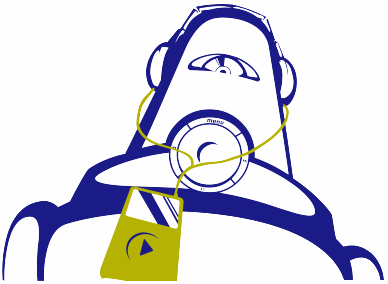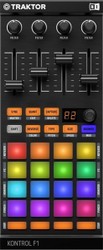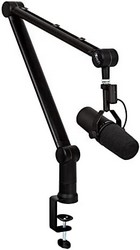HOW I MAKE PODRUNNER & GROOVELECTRIC
This page details the equipment & software I use to make Podrunner and Groovelectric, and describes my weekly process for creating the mixes. It also helps explain why I ask for contributions. It takes a lot to make something happen when you press Play!
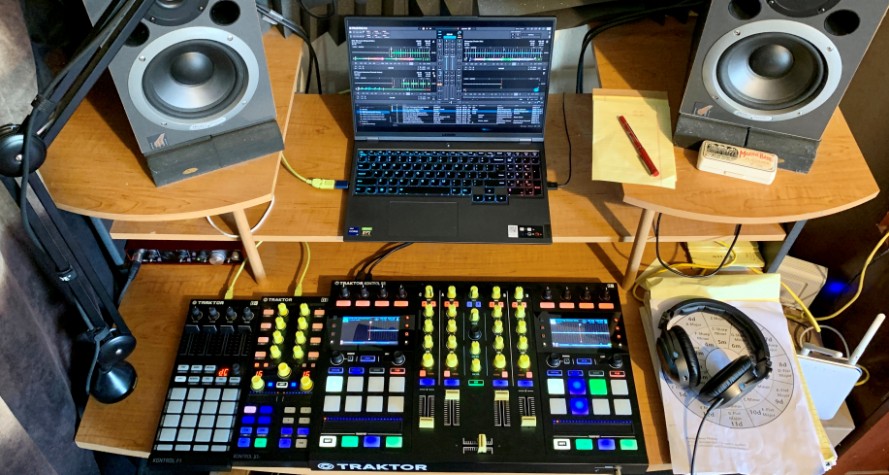
STUDIO
I live in an open-plan home that used to be a small library, so my studio is a corner sectioned-off with sound-blocking curtains and acoustic-foam panels. The place is high-ceilinged, so there's no way to avoid reverb when I record vocals. short of building an isolation booth. Instead, I remove reverb after recording, using software plugins that, sometimes, are straight-up magic.
GEAR
Music Mixing
I record on a Lenovo Legion 5i Pro laptop running Windows 11, made possible by my amazing listeners. I DJ studio & live using Native Instruments Traktor Pro 3, with Native Instruments Kontrol S5, Kontrol X1, and Kontrol F1 controllers, and Sennheiser HD7 headphones.
Post-recording, I edit the mixes in Sound Forge Pro using iZotope Ozone 11 Advanced and Waves' L3 Multimaximizer plugins.
Vocal Recording
I record each episode's intro using Sound Forge Pro with a Shure SM7B microphone plugged into an SE Electronics DM1 Dynamite mic preamp (I recommend it over the more commonly paired Cloudlifter) and mounted on a Rode PSA-1 swing-arm; a Focusrite Scarlett 2i4 audio interface; and Ultrasone HFI-700 headphones
I treat my raw vocal with an effects chain of Waves' Clarity Vx Pro, Izotope RX10 Advanced Breath Control, Waves DeEsser, and Izotope Nectar 4 Plus with EQs & Compressor. I monitor with Event Project Studio 6 studio monitors and an M-Audio BX10s subwoofer, though I don't use them very often anymore.
Website
Podrunner & Groovelectric each have a large and ever-growing mix archive that needs a space-saving solution. Expandable accordions seemed to be a good option, and since WordPress is very clunky for that and I'm much more conversant with HTML than with PHP, I designed and maintain both websites using Website X5 Pro. The accordions were designed using DW Accordions for Dreamweaver from Extend Studios (the extension is free now!).

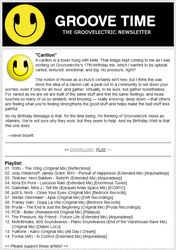 Newsletters
NewslettersI still use Dreamweaver 8 (!) to compose and edit the Runtime and Groovetime newsletters. I distribute them using EasySendy Pro and an Amazon Web Services account. It's a lot cheaper than MailChimp & equivalent services, but it's a pain to set up.
A new newsletter goes out as soon as a new episode goes online. It has direct MP3 links, player links, playlists, background info, and whatever else I think will inform or entertain my listeners. With Groovelectric, I occasionally do exclusive mixes for newsletter subscribers.
Host
Libsyn for both podcasts, since 2006. I believe strongly in podcasters hosting their own feeds, though, and Podrunner and Groovelectric's RSS feeds are on their respective websites. I code the feeds manually, because I'm dumb like that.
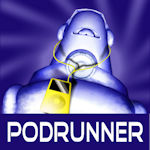
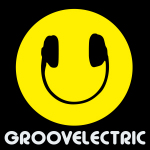 Artwork
ArtworkI do all the graphic work for the websites & newsletters. For graphics and photo editing I use PaintShop Pro.
The Podrunner logo was designed in collaboration with much-missed animator and designer Joe Riley. I know that it's a bit dated now, but I can't bear to part with it. I designed the Groovelectric logo after accidentally holding up a pair of headphones in front of something circular.
PROCESS
Work on the podcasts takes up some time nearly every day, alternating one week for Podrunner and the next for Groovelectric. It generally runs like this:
Saturday
- Listen to promo tracks that came in during the week.
- Conform downloaded track filenames and metadata with MP3tag and Traktor for easier sorting, searching, and playlisting later on.
- Analyze and categorize in Traktor.
Sunday
- Search for & audition non-promo music and audio sources, especially for Groovelectric.
Monday
- Audition tracks for this week's mix. If this goes fast it's 3-4 hours auditioning anywhere from 50 to 200 tracks to find about 20 tracks that work. If it doesn't go fast it's a day or two.
Tuesday*
- For Podrunner, pare down the tracklist to fit an hour-long length.
- Sequence, remove & replace tracks as needed, until I'm happy with the fit and flow.
- Practice blends if they're especially complicated (more than 2 decks, importantly timed vocals).
- Record the mix. This is the shortest time-block of the entire process, and it's what all the rest orbits around. It's also my favorite part. It's important to me that the mixes be playable live and not be studio creations, so if I screw up, I start over. This happens more often with Groovelectric, as Podrunner is much more straightforward.
- Edit the recorded mix in Sound Forge Pro, tweaking volume and EQ to get a more consistent level. Master the mix with Izotope Ozone 10, then do a final pass with Waves L3 Multimaximizer.
*This casually says Tuesday, but the steps listed for this day can easily take 2-3 days, or even longer. Self Awareness, for example, took a week of prep, a day of practice, and 10 takes.
Wednesday
- QA the mix on my very after-market car stereo as I run errands.
- Listen again on headphones as I write this week's newsletter.
- Update the website with Website X5 Pro; update the RSS feed with Dreamweaver 8.
- Write the intro in WordPerfect (screw you, MS Word).
- Record the intro. I do at least three takes, but usually a lot more, because I'm picky and because I'm mic-conscious. I pick the best take (usually the most recent), edit it, and apply chained audio presets to remove reverb, reduce breaths & my hissy S, EQ, and compress for consistent volume level.
- Mix the finished vocal with my theme music (I composed the Podrunner and Groovelectric themes using Reason Studios Reason [Fun Fact: That's me playing guitar on the Podrunner theme opening]). Normalize the music-backed intro with Waves L3 Multimaximizer, then paste it to the beginning of the mix. Check levels, then save the mix as a 320K MP3.
- Apply metadata to the episode MP3 with iTunes. (Fun Fact: The playlist is in the Lyrics section of every mix.)
Thursday
- Add final info (MP3 duration & size) to the RSS feed. Upload the feed to a temp directory & check for errors.
- Upload the episode to Libsyn and launch it.
- Upload the updated website.
- Upload the newsletter and send it out to subscribers as soon as the mix shows up on podcast apps.
Adding it all up (and the above is by no means everything), I'd say each hour-long episode represents between 16-20 hours of work. More, if anything goes sideways.
LIST
Hardware
Lenovo Legion 5i Pro Laptop
Native Instruments Kontrol S5 Controller
Native Instruments Kontrol X1 Controller
Native Instruments Kontrol F1 Controller
Shure SM7B microphone
SE Electronics DM1 mic preamp
Focusrite Scarlett 2i4 audio interface
Sennheiser HD7 headphones
Ultrasone HFI-700 headphones
Event Project Studio 6 monitors
M-Audio BX10s subwoofer
Rode PS1 Swing Arm
Services
Bluehost site hosting
Libsyn podcast hosting
EasySendy Pro newsletter mailout
Amazon Web Services
Software
Traktor Pro 3 DJ software
Sound Forge Pro 16 audio editor
Izotope Plugins:
- Ozone 11 Advanced mastering software
- RX10 Advanced audio repair
- Nectar 4 Plus vocal mixing
Waves Plugins:
- L3 Multimaximizer
- Clarity VX Pro background/noise reduction
- De-Ess
- De-Breath
Website X5 Pro
MP3tag
Renamer
iTunes
WordPerfect
PaintShop Pro
Dreamweaver 8 (!)
